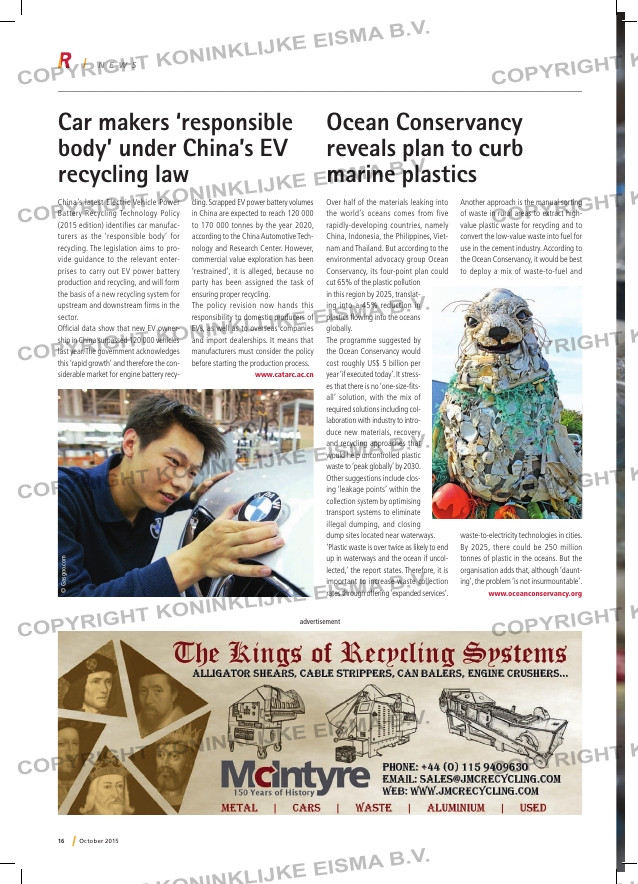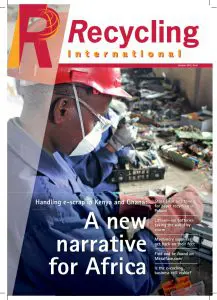Page 18 from: October 2015

16 October 2015
N E W S
SSI Shredding Systems, Inc.
www.ssiworld.com | [email protected] | +1-503-682-3633 See every imaginable thing being shredded at www.watchitshred.com
WHAT NEEDS SHREDDING?
®
STARTING FROM SCRATCH
IS SO LAST CENTURY
In fact, nearly every type of plastic in the
market today is either recycled into new
material or converted to fuel.
From manufacturing waste and baled plastics
to security product destruction, SSI designs
and builds shredding systems that efficiently
shred, bale break or pre-process plastics for
recycling or plastic-to-fuel applications. With
SSI’s new SmartFeed™ system, even the
toughest materials like baled super sacks,
yarn or films can now be shredded at higher
rates with less equipment wear and tear.
To discover how to maximize your plastics
processing, check out our video at
go.ssiworld.com/plastics
Of course, we always start with that first
critical question…
Plastics-RI-2015.indd 1 9/4/15 11:06 AM
advertisement
Car makers ‘responsible
body’ under China’s EV
recycling law
China’s latest Electric Vehicle Power
Battery Recycling Technology Policy
(2015 edition) identifies car manufac-
turers as the ‘responsible body’ for
recycling. The legislation aims to pro-
vide guidance to the relevant enter-
prises to carry out EV power battery
production and recycling, and will form
the basis of a new recycling system for
upstream and downstream firms in the
sector.
Official data show that new EV owner-
ship in China surpassed 120 000 vehicles
last year. The government acknowledges
this ‘rapid growth’ and therefore the con-
siderable market for engine battery recy-
cling. Scrapped EV power battery volumes
in China are expected to reach 120 000
to 170 000 tonnes by the year 2020,
according to the China Automotive Tech-
nology and Research Center. However,
commercial value exploration has been
‘restrained’, it is alleged, because no
party has been assigned the task of
ensuring proper recycling.
The policy revision now hands this
responsibility to domestic producers of
EVs, as well as to overseas companies
and import dealerships. It means that
manufacturers must consider the policy
before starting the production process.
www.catarc.ac.cn
Ocean Conservancy
reveals plan to curb
marine plastics
Over half of the materials leaking into
the world’s oceans comes from five
rapidly-developing countries, namely
China, Indonesia, the Philippines, Viet-
nam and Thailand. But according to the
environmental advocacy group Ocean
Conservancy, its four-point plan could
cut 65% of the plastic pollution
in this region by 2025, translat-
ing into a 45% reduction in
plastics flowing into the oceans
globally.
The programme suggested by
the Ocean Conservancy would
cost roughly US$ 5 billion per
year ‘if executed today’. It stress-
es that there is no ‘one-size-fits-
all’ solution, with the mix of
required solutions including col-
laboration with industry to intro-
duce new materials, recovery
and recycling approaches that
would help uncontrolled plastic
waste to ‘peak globally’ by 2030.
Other suggestions include clos-
ing ‘leakage points’ within the
collection system by optimising
transport systems to eliminate
illegal dumping, and closing
dump sites located near waterways.
‘Plastic waste is over twice as likely to end
up in waterways and the ocean if uncol-
lected,’ the report states. Therefore, it is
important to increase waste collection
rates through offering ‘expanded services’.
Another approach is the manual sorting
of waste in rural areas to extract high-
value plastic waste for recycling and to
convert the low-value waste into fuel for
use in the cement industry. According to
the Ocean Conservancy, it would be best
to deploy a mix of waste-to-fuel and
waste-to-electricity technologies in cities.
By 2025, there could be 250 million
tonnes of plastic in the oceans. But the
organisation adds that, although ‘daunt-
ing’, the problem ‘is not insurmountable’.
www.oceanconservancy.org ©
G
as
go
o.
co
m



